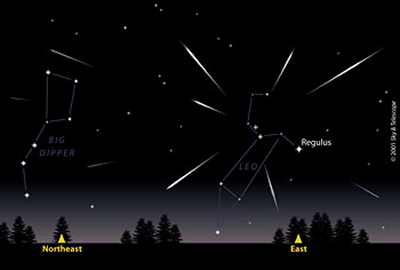Hi. Here I am to share my experience on
Leonids 2008. Well, November 17, 2008 is D-day, and here it is. Alarm was set-up at 3:00am on my mobile to start my first meteor hunt (my second actually. My first was 2005 Leonids which I was looking at a complete wrong time and hence failed).
I woke up from a dream (not a nightmare), and discovered that the time was 3:40 and the alarm was off. I didn’t know whether to call myself lucky or unlucky. Went straight to my terrace and I realized that I am, actually unlucky. It was overcast, especially the east horizon. Since the constellation Leo is said to be at the east horizon and that the meteors appear to origin from that constellation, I wasn’t really happy.
Went back downstairs and scanned through the Planetarium Software on my system to find the exact location of the constellation Leo. It was about nearly 4:10 when I decided to go back to my terrace.
I was happy that the sky was partly clear and that the clouds were moving pretty fast. I positioned myself such that I could see the east part of the sky quite clearly. I kept looking there for about 20 mins with no success. During this time I was also trying to identify the constellation Leo. All I could see was two stars near the horizon. At around 4:30 I noticed more stars at the east horizon and I realized that the brighter of the two stars was Regulus (Constellation Leo) and another bright at the dead east was actually Saturn. I decided to go back to my computer to check the planetarium software again and that was moment I would never forget for the rest of my life.
4:32 am – I spotted my first ever meteor. It was to the right of Regulus. It was moving further right away from Regulus. Yes, it was a Leonid and it was moving away from Leo. It was short compared to what I saw in youtube. And quick! Very quick! If I had attempted to blink I may not have caught it after all.
I was really excited. I was literally jumping with joy. Now I noticed that the sky is much clear. I was looking at Sirius, how bright it was; and Orion (my favorite constellation); and the Moon, was really bright. And then –
4:37 am – Another one - To the north of the Moon - Moving towards the west. Again away from Leo (Leo was still at the east). I realized that the meteor may not actually appear near the constellation. Moon was at the constellation Gemini and so was this meteor.
I ran back downstairs and woke up mom. My friend, Kavin messaged me asking if it was worth having a look. Somehow I convinced him to go to his terrace and have a try. Nearly 30 mins later my mom said she was tired and she went back. Bad Luck for her, I thought. A little while later, Kavin messaged me saying it was getting cloudy again and that he was quitting. Bad Luck for him too. I went back to my computer to confirm the location of Leo and Saturn.
Went back upstairs and by now I was really fed up. No meteors in the last 45 mins. I just turned to see if the sky was clear and again –
5:27 am – Another. My third lucky meteor! This one was a little above the north horizon, moving from east to west. Again, away from Leo! This was when I realized how wrong I was. I thought that Leonids would appear near Leo. Now I realized that it can appear anywhere in the sky. The only thing was that it appears to move away from Leo.
Now I decided to stand up and look all over the sky. I was sure I missed a lot of them when I was only looking at east. I’m not gonna miss anymore. 10 mins later I felt I saw a faint meteor near the east horizon. Bright Moon and tiny source of light at the east (rising Sun), it could have really been a meteor but I might have imagined as well.
In another 10 mins light was growing on the east. I realized that I was finding difficult to spot even Orion. All I was able to see on the sky apart from Moon was Sirius, Regulus, Rigel and Saturn. All the other stars had faded due to the growing sun light. That was when I decided to quit my first meteor hunt. Pretty successful. But that’s not the end of the story. Geminids still waiting on December.
 The above picture is an illustration of the conjunction between Venus and Jupiter and the triangle with the Moon. In India, it can be viewed after sunset and not at 9pm.
The above picture is an illustration of the conjunction between Venus and Jupiter and the triangle with the Moon. In India, it can be viewed after sunset and not at 9pm.





